
In the realm of baking, possessing a firm grasp of the essential tools and ingredients is paramount to achieving delectable and awe-inspiring results. Whether you are a seasoned baker or a novice, familiarity with these baking essentials will serve as your compass to navigate the delightful world of pastry arts. From measuring accurately to choosing the finest flours, this guide will equip you with the knowledge necessary to embark on a culinary journey that will captivate your taste buds and impress even the harshest connoisseurs.
The Essential Ingredients
When it comes to baking, the right combination of ingredients can transform a simple mixture into a masterpiece. But fear not, as the essential ingredients can be found in the most basic of pantries and grocery stores. Here, we will delve into the fundamental components that lend flavor, structure, and texture to your delectable creations.
Flour
The backbone of baking, flour provides the necessary structure to your baked goods. All-purpose flour is a versatile option, suitable for a wide range of recipes. However, specialty flours such as cake flour or bread flour can be used for specific projects to achieve a desired texture. Remember to whisk or sift your flour before measuring to ensure accurate proportions.
Sugar
Sweetness is vital in many baked goods, and sugar plays a multifaceted role. Granulated sugar adds sweetness, while brown sugar contributes moisture, richness, and a subtle molasses flavor. Powdered sugar, also known as confectioners’ sugar, is perfect for dusting atop cakes and cookies or for making frostings and glazes.
Leavening Agents
Leavening agents are responsible for creating lightness and volume in your baked treats. Baking powder and baking soda are the most common leavening agents. Baking powder is a combination of baking soda, cream of tartar, and a dry acid. It works well in recipes that contain acidic ingredients. Baking soda, on the other hand, requires an acidic ingredient to activate its leavening properties.
Butter and Oil
Fats are essential for adding tenderness, moisture, and flavor to your bakes. Butter, with its rich creamy taste, is a staple in many recipes. Unsalted butter is preferred, as it allows you to control the salt content. Oil, such as vegetable or canola oil, is often used in recipes that require a moist and tender crumb.
Eggs
Eggs are the backbone of many baked goods, acting as a binding agent and contributing to structure and moisture. Large eggs are the standard in most recipes, but be sure to follow your recipe’s specifications.
Vanilla Extract
A small amount of vanilla extract can elevate the flavor profile of your baked creations. Its warm and comforting notes add depth and complexity to your treats. Opt for pure vanilla extract whenever possible for the best flavor.
Salt
While often overlooked, salt is a crucial ingredient in baking. It enhances the flavors of other ingredients and helps to balance sweetness. A pinch of salt can make all the difference in bringing out the best in your baked goods.
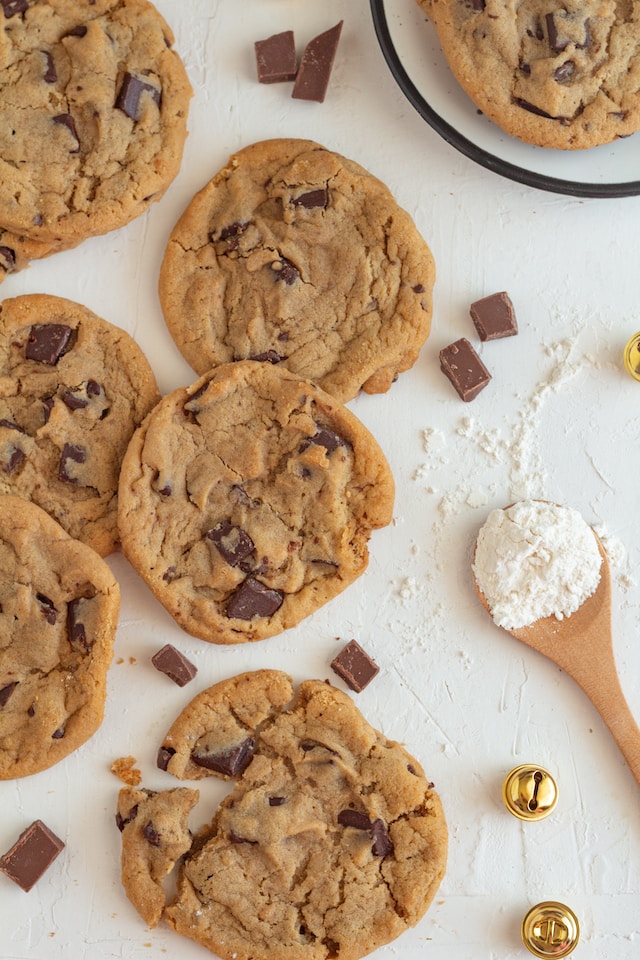
Essential Baking Equipment
To embark on your baking journey, it is imperative to equip yourself with the necessary tools of the trade. Here, we will explore the essential baking equipment that will elevate your culinary creations to new heights.
- Mixing Bowls: A baker’s arsenal is incomplete without a set of sturdy mixing bowls. These versatile vessels come in various sizes and materials, including stainless steel, glass, and ceramic. Choose a selection that suits your needs, allowing you to effortlessly mix batters and doughs with precision and ease.
- Measuring Cups and Spoons: Accurate measurements are the cornerstone of successful baking. Invest in a reliable set of measuring cups and spoons to ensure that your ingredients are measured precisely. Whether it be flour, sugar, or vanilla extract, these tools will help you achieve the perfect balance in your recipes.
- Whisks and Spatulas: Whisks and spatulas are the unsung heroes of the baking world. A sturdy whisk will effortlessly combine your ingredients, while a spatula will help you scrape down the sides of bowls and fold in delicate mix-ins. Both are essential for achieving smooth and uniform batters.
- Baking Pans: The right baking pans are essential for achieving optimal results. From cake pans and muffin tins to cookie sheets and loaf pans, there is a vast array of options to choose from. Consider the type of recipe you are preparing and select the appropriate pan size and material to ensure even baking and impeccable presentation.
- Cooling Racks: Cooling racks are indispensable for allowing your baked goods to cool evenly and thoroughly. By elevating your creations off the hot baking sheets, these racks promote air circulation, preventing sogginess and ensuring a crispy exterior.
- Rolling Pin: For those indulging in the art of pastry, a rolling pin is an essential tool. This humble instrument allows you to effortlessly roll out doughs for pies, tarts, and pastries, ensuring an even thickness and a picture-perfect result.
- Pastry Brush: A pastry brush, often underestimated, plays a crucial role in glazing, brushing on a wash, or applying melted butter. Look for a brush with bristles that are both sturdy and gentle, allowing for precise application without damaging delicate pastry surfaces.
- Oven Thermometer: An accurate oven temperature is vital to baking success. Unfortunately, oven thermostats can sometimes be inaccurate. To ensure that your bakes come out perfectly every time, invest in an oven thermometer. This nifty gadget will help you gauge the true temperature inside your oven, giving you the confidence to bake with precision.
Baking Techniques and Tips
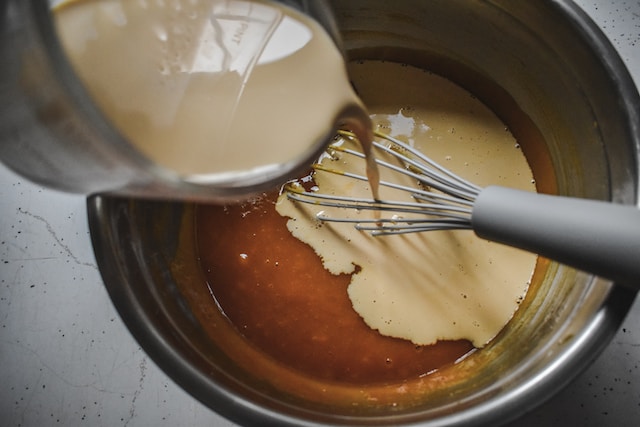
Mastering the art of baking not only requires the right ingredients and equipment but also a solid foundation of baking techniques and tips. These time-honored practices will elevate your creations from ordinary to extraordinary, ensuring that your baked goods are a feast for the senses.
1. Preparing Your Workspace: Before diving into a baking adventure, it is essential to prep your workspace. Make sure your countertop is clean and spacious, with all necessary ingredients and tools at arm’s reach. Clear your mind of distractions and create a serene environment where your creativity can flourish.
2. Room Temperature Ingredients: Many baking recipes call for ingredients to be at room temperature. This allows for better incorporation and a more even baking process. Take the time to pull out eggs, butter, and other perishable items from the fridge and let them sit on the counter for about 30 minutes before using them.
3. Mixing Techniques: When it comes to mixing the ingredients, different recipes call for different techniques. Be gentle when folding in delicate ingredients, such as whipped egg whites or chocolate chips. Use a light hand and a spatula to maintain the structural integrity of your batters.
4. The Creaming Method: The creaming method is a classic technique used for various recipes, such as cakes and cookies. Start by beating softened butter and sugar together until light and fluffy. This process incorporates air into the mixture, resulting in a tender and light texture. Add eggs one at a time, beating well after each addition, and then slowly incorporate the dry ingredients.
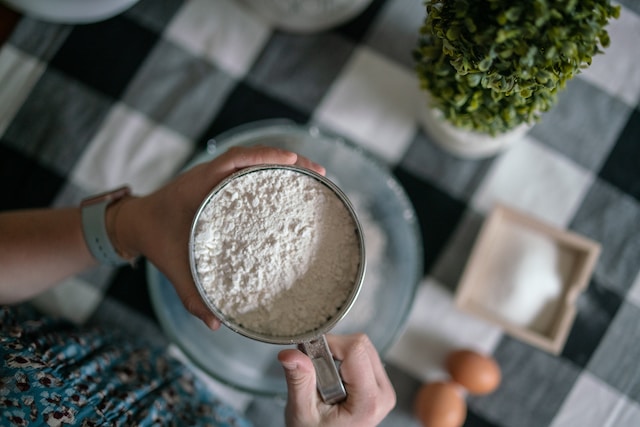
5. Sifting Flour: Sifting flour might seem like an unnecessary step, but it can make a significant difference in your baked goods’ texture. Sifting aerates the flour, removing any lumps and ensuring proper measurement.
This process allows for better incorporation of ingredients and results in a lighter and finer crumb.
6. Proper Cooling: Once your baked creation is out of the oven, resist the temptation to immediately indulge. Instead, transfer it to a cooling rack to allow for even cooling. This step prevents the bottom from becoming soggy and helps maintain the desired texture.
7. Decorating and Presentation: Baking is not just about taste, but also about pleasing the eyes. Enhance the presentation of your baked goods by adding simple decorations, such as sprinkling powdered sugar, drizzling glazes, or arranging fresh fruits. Let your creativity run wild and create edible masterpieces that are a feast for both the eyes and palate.
8. Practice and Patience: Baking is an art that requires practice, patience, and a willingness to learn from each experience. Don’t be discouraged by initial failures; instead, embrace them as opportunities to improve. Pay attention to the details, experiment with new recipes, and savor the joy that baking brings.
Basic Baking Recipes
Classic Chocolate Chip Cookies
INGREDIENTS:
- 2 1/4 cups all-purpose flour
- 1 teaspoon baking soda
- 1/2 teaspoon salt
- 1 cup unsalted butter, softened
- 3/4 cup granulated sugar
- 3/4 cup packed brown sugar
- 1 teaspoon vanilla extract
- 2 large eggs
- 2 cups semisweet chocolate chips

Instructions:
1. Preheat your oven to 375°F (190°C) and line a baking sheet with parchment paper.
2. In a medium-sized bowl, whisk together the flour, baking soda, and salt. Set aside.
3. In a larger bowl, cream together the softened butter, granulated sugar, and brown sugar until light and fluffy. Add in the vanilla extract and mix well.
4. Beat in the eggs, one at a time, until fully incorporated.
5. Gradually add the flour mixture to the wet ingredients, mixing until just combined. Be careful not to overmix.
6. Fold in the chocolate chips until evenly distributed throughout the dough.
7. Drop tablespoonfuls of dough onto the prepared baking sheet, spacing them about 2 inches apart.
8. Bake for 9-11 minutes, or until the edges are golden brown. The centers may still appear slightly undercooked, but they will set as they cool.
9. Allow the cookies to cool on the baking sheet for a few minutes before transferring them to a wire rack to cool completely.
Classic Vanilla Cupcakes
Ingredients:
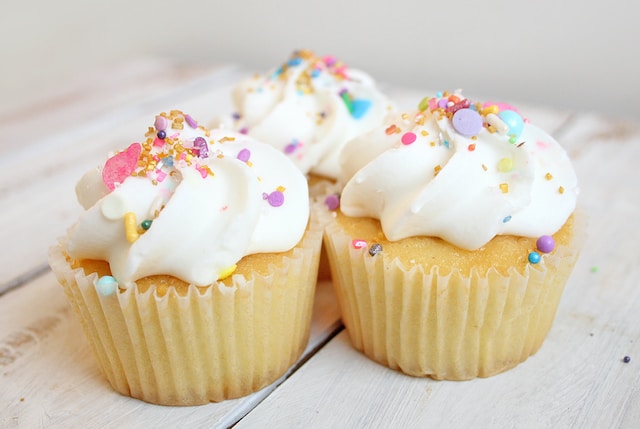
- 1 3/4 cups all-purpose flour
- 1 1/2 teaspoons baking powder
- 1/2 teaspoon baking soda
- 1/4 teaspoon salt
- 1/2 cup unsalted butter, softened
- 1 cup granulated sugar
- 2 large eggs
- 1 teaspoon vanilla extract
- 1 cup buttermilk
Instructions:
1. Preheat your oven to 350°F (175°C) and line a cupcake pan with paper liners.
2. In a medium-sized bowl, whisk together the flour, baking powder, baking soda, and salt. Set aside.
3. In a larger bowl, cream together the softened butter and granulated sugar until light and fluffy.
4. Beat in the eggs, one at a time, followed by the vanilla extract.
5. Gradually add the dry ingredients to the butter mixture, alternating with the buttermilk. Begin and end with the dry ingredients, mixing until just combined.
6. Divide the batter evenly among the cupcake liners, filling each about two-thirds full.
7. Bake for 18-20 minutes, or until a toothpick inserted into the center of a cupcake comes out clean. The cupcakes should be light golden brown and spring back when lightly touched.
8. Allow the cupcakes to cool in the pan for a few minutes before transferring them to a wire rack to cool completely.
Homemade Pizza Dough
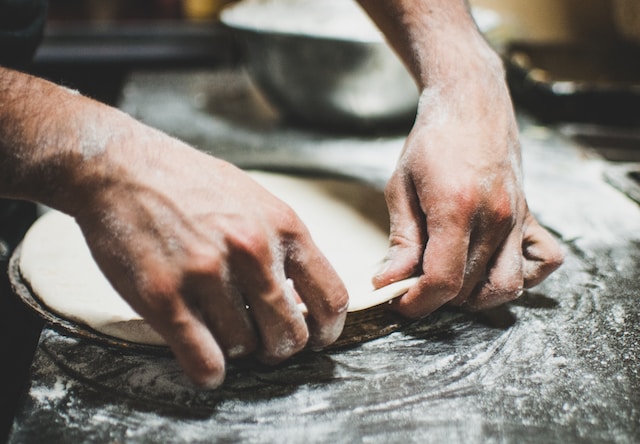
Ingredients:
- 3 1/2 cups all-purpose flour
- 2 teaspoons active dry yeast
- 1 teaspoon salt
- 1 teaspoon sugar
- 1 1/4 cups warm water
- 2 tablespoons olive oil
Instructions:
1. In a small bowl, combine the warm water, yeast, and sugar. Let it sit for about 5-10 minutes, or until the mixture becomes frothy.
2. In a larger bowl, whisk together the flour and salt.
3. Pour the yeast mixture and olive oil into the bowl with the dry ingredients.
4. Stir the ingredients together until a dough forms.
5. Transfer the dough onto a lightly floured surface and knead it for about 5-7 minutes, or until it becomes smooth and elastic.
6. Place the dough in a greased bowl, cover it with a clean kitchen towel, and let it rise in a warm place for about 1-2 hours, or until it has doubled in size.
7. Once the dough has risen, punch it down to release any air bubbles.
8. Divide the dough into desired portions for pizza crusts. Roll out each portion into a circular shape, about 1/4-inch thick.
9. Preheat your oven to 475°F (245°C) and transfer the rolled-out dough onto a baking sheet or pizza stone.
10. Add your desired toppings and bake for about 12-15 minutes, or until the crust is golden brown and the cheese is melted and bubbly.
These basic baking recipes will serve as a starting point for your culinary adventures. Feel free to experiment with flavors, fillings, and decorations to make each recipe your own. With practice and a dash of creativity, you’ll soon be able to create baked masterpieces that will leave your loved ones and guests in awe. Happy baking!
